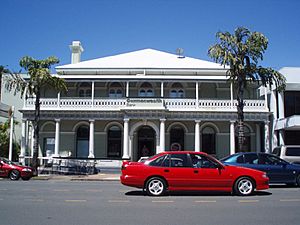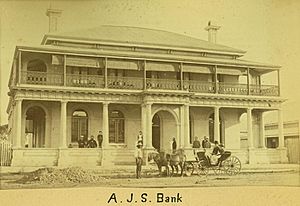Commonwealth Bank Building, Mackay facts for kids
Quick facts for kids Commonwealth Bank Building, Mackay |
|
|---|---|

Commonwealth Bank of Australia, Mackay, 2009
|
|
| Location | 63 Victoria Street, Mackay, Mackay Region, Queensland, Australia |
| Design period | 1870s–1890s (late 19th century) |
| Built | 1880 |
| Architect | Francis Drummond Greville Stanley |
| Architectural style(s) | Classicism |
| Official name: Commonwealth Bank of Australia, Australian Bank of Commerce Limited, Australian Joint Stock Bank | |
| Type | state heritage (built) |
| Designated | 21 October 1992 |
| Reference no. | 600671 |
| Significant period | 1880s (fabric) 1881-ongoing (historical use) |
| Significant components | residential accommodation - manager's house/quarters, banking chamber, safe |
| Builders | Southall & Tracey |
| Lua error in Module:Location_map at line 420: attempt to index field 'wikibase' (a nil value). | |
The Commonwealth Bank Building in Mackay, Queensland, is a very old and important bank building. It's located at 63 Victoria Street. This historic building was designed by Francis Drummond Greville Stanley and built in 1880. It was originally known as the Australian Joint Stock Bank. Later, it became the Australian Bank of Commerce. Today, it is recognized on the Queensland Heritage Register as a special place.
History of the Building
The Commonwealth Bank building was built in 1880. It was first home to the Australian Joint Stock Bank. This makes it the oldest business building in Mackay!
Early Banks in Queensland
The Australian Joint Stock Bank started in 1852 when gold was found in southern Australia. It opened branches in many places, including Queensland goldfields. The Mackay branch opened in this very building in 1881.
Mackay's Growth and Development
The town of Mackay is named after John Mackay, who explored the area in 1860. A settlement began in 1862, and by 1863, the town was mapped out. Mackay quickly grew as a port and a business hub. It served nearby farms and sugar plantations. The 1880s were a time of great growth for Queensland. Mackay became an important regional center, especially for the sugar industry.
Building Design and Construction
The new Australian Joint Stock Bank building was one of many designed by F D G Stanley. He was a famous architect for the Queensland government. Another architect, Arthur Josling, oversaw the building work. The construction was done by Southall and Tracey from Brisbane. Work started in January 1880, and the bank opened its doors on February 5, 1881.
Mackay in the 20th Century
Even after a big cyclone in 1918, Mackay grew a lot in the 1920s and 1930s. It was one of the fastest-growing towns in Queensland! This was partly because a railway line connected Mackay to other areas in 1924. This helped the sugar industry and also new dairy and tourism businesses.
Changes in Bank Ownership
The Australian Joint Stock Bank Limited changed its name to the Australian Bank of Commerce in 1910. It kept that name until 1931. Then, another bank, the Bank of New South Wales, took it over. In 1934, the Commonwealth Savings Bank moved into this building.
The Queensland Government Savings Bank had an office in the Mackay Post Office since 1865. This bank helped working people save money. In 1921, it joined with the Commonwealth Savings Bank. The Mackay branch then moved into this building, which used to be the Australian Bank of Commerce.
Recent Condition of the Building
Over the years, the inside of the building has been changed many times. Since 2014, the building has needed a lot of repairs. Parts of its outer walls have been stripped, leaving the bricks open to the weather. People in Mackay are worried about the building's future. They hope it can be saved and repaired soon.
What the Building Looks Like
The Commonwealth Bank building has two floors. The top floor used to be where the bank manager lived. There's also an extension on the right side. The windows on the ground floor have been updated. You can find the night safe on the left side of the front.
Front of the Building
The front of the building has a row of seven columns, called a colonnade. The middle part is a bit narrower and has the main entrance. This entrance sticks out a little. The columns are round and stand on bases. A low wall connects these bases. Above the columns, there are decorations called triglyphs, which are common in classical buildings.
Upper Floor and Roof
The upper floor has thinner metal columns above the stone ones. These hold up the roof of the veranda, which is made of corrugated iron. The railing of the veranda has pretty cast iron lace with a pattern of circles. The main roof is shaped like a hip roof. Arched windows connect the veranda to the upper floor. These windows have two glass doors, and the top part of each door is also arched. The roof is made of corrugated iron. A decorated chimney rises on the left side.
Building Materials and Details
The outside walls on both levels are covered in stucco. This stucco is marked to look like large, smooth stone blocks, called ashlar masonry. The ceiling of the lower veranda is made of wooden boards. The upper floor's ceiling is also lined with wooden boards, but these are narrower and have a ribbed design.
The main banking area on the ground floor has a central main door. There are also two other doors that might have been windows once.
Why This Building is Important
The Commonwealth Bank of Australia building was added to the Queensland Heritage Register on October 21, 1992. This means it's considered a very important historical place.
Showing Queensland's History
Mackay was a major sugar center. It played a big role in Queensland's economy in the late 1800s. This bank building shows how important Mackay was and how well-off the city was back then. It is also the oldest commercial building still standing in Mackay.
A Great Example of Its Type
This building is a good example of a regional bank from its time. Its design looks strong and traditional, which was common for banks. It also had a home for the bank manager on the upper floor, which was a typical setup.
Beautiful and Important Design
The building was designed by F.D.G. Stanley, one of Queensland's most important architects. It's a beautiful and detailed building that adds a lot to the look of Mackay's town center.
Linked to Important People and Groups
The Commonwealth Bank building was first built for the Australian Joint Stock Bank. It is an important commercial building designed by F.D.G. Stanley. He helped shape many buildings in Queensland, both for the government and in his private work. The building is also connected to the history of the Australian Joint Stock Bank, which was once the biggest bank in Queensland.


